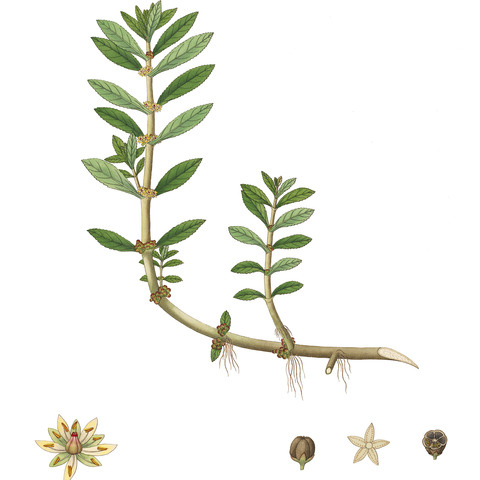Herbs annual, 15-30 cm tall. Stem prostrate and rooting in lower part, terete, slightly fleshy, glabrous; branches erect. Stipules ovate-triangular, membranous, margin dentate-sinuate; petiole 1-5 mm, flattened; leaf blade elliptic-lanceolate, obovate-lanceolate, or obovate, 1-4 × 0.2-1 cm, papery, base acuminate, margin minutely serrulate or subentire, apex acute or attenuate. Flowers arranged into small, axillary cymes, subsessile or with short pedicel 1-5 mm, very small. Sepals erect, narrowly lanceolate, 1-2 mm. Petals pink, oblong or subspatulate, subequaling or slightly exceeding sepals. Stamens 10, free; filaments filiform, base slightly widened. Ovary subglobose; styles straight or curved. Capsule subglobose, ca. 1.8 mm in diam., longitudinally 5-grooved, 5-septicidal. Seeds oblong, minute, angular or transversely striate.
Succulent, glabrous aquatic annuals with erect stems from a creeping rhizome. Roots numerous at each rhizome node, stout, with many long thin side roots. Stems up to 25 cm long, and up to 7 mm in diam., unbranched or with a few short side branches, succulent. Leaves reduced below, upper fairly close together, narrowly ovate, up to 4 cm long and 1 cm broad, attenuate below, shallowly serrate, thin; stipules small. Flowers small, in many-flowered, tight clusters, sessile or very shortly pedicellate. Sepals narrowly ovate, 1.5 mm long, membranous with entire margins. Petals narrowly ovate, slightly longer, pale lilac. Stamens 10. Ovary globose, styles short. Capsule globose, the valves flattened and recurved at dehiscence; seeds subcylindrical, straight or slightly bent, 0.8 mm long, tesselate, shiny yellow brown.
Herb with a creeping, 8-50 cm long main stem and ascending branches; stems terete, red or pink, faintly shining. Stipules erect, ovate-triangular, long-acuminate, acute, dentate, membranous, 2-3 mm long. Leaves subsessile, oblong-lanceolate or lanceolate, from an acute base, acute, finely serrulate, with red teeth, 1½-5 by ¾-2½ cm; petiole 1-5 mm. Flowers in many-flowered, dense clusters, 5-merous. Sepals erect, broadly elliptic, shortly acuminate, acute, light green, tipped with red, 1½-2 mm long. Petals at first erect, afterwards widely patent or recurved, oblong or subspathulate, white, transparent. Filaments thin, filiform from a slightly broadened base. Ovary subglobose; styles erect-recurved, ¼-⅓ mm long. Capsule subglobose, with 5 longitudinal furrows, ± 2½ mm diam. Seeds slightly less than½ mm long.
Succulent annual herb, hydrophyte, 250 mm tall. Valves of capsule flat and recurved at dehiscence. Flowers with short pedicels, in many-flowered, tight clusters. Flowers pale lilac; January to February and in May.
Aquatic herb with pink succulent stems procumbent and rooting at the nodes or erect.


